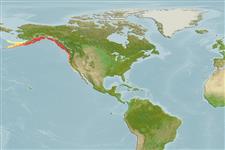Environment: milieu / climate zone / depth range / distribution range
Ecología
marino batidemersal; rango de profundidad 18 - 1008 m (Ref. 2850). Deep-water
Northeast Pacific: Shelikof Strait, western Gulf of Alaska to southern British Columbia; northern California, USA.
Tamaño / Peso / Age
Maturity: Lm ? range ? - ? cm
Max length : 10.0 cm TL macho / no sexado; (Ref. 2850)
Short description
Claves de identificación | Morfología | Morfometría
Espinas dorsales (total) : 0; Radios blandos dorsales (total) : 56 - 59; Espinas anales: 0; Radios blandos anales: 44 - 49. Dorsal fin extending to about half length of caudal fin and no raised lobe at anterior end; caudal reduced but recognizable, attached to dorsal and anal fins; anal extends about to half length of caudal fin; lower rays of pectorals greatly exserted; pelvic fins and adhering disc absent (Ref. 6885).
Life cycle and mating behavior
Maturities | Reproducción | Spawnings | Egg(s) | Fecundities | Larva
Stein, D.L., 1978. A review of the deepwater Liparidae (Pisces) from the coast of Oregon and adjacent waters. Proc. Cal. Acad. Sci. 127:1-55. (Ref. 26773)
IUCN Red List Status (Ref. 130435)
Threat to humans
Harmless
Human uses
Herramientas
Special reports
Download XML
Fuentes de Internet
Estimates based on models
Preferred temperature (Ref.
123201): 4.2 - 7.7, mean 5.6 °C (based on 117 cells).
Phylogenetic diversity index (Ref.
82804): PD
50 = 0.5000 [Uniqueness, from 0.5 = low to 2.0 = high].
Bayesian length-weight: a=0.00525 (0.00237 - 0.01161), b=3.15 (2.96 - 3.34), in cm total length, based on LWR estimates for this (Sub)family-body shape (Ref.
93245).
Nivel trófico (Ref.
69278): 3.4 ±0.5 se; based on size and trophs of closest relatives
Resiliencia (Ref.
120179): Alto, población duplicada en un tiempo mínimo inferior a 15 meses (Preliminary K or Fecundity.).
Fishing Vulnerability (Ref.
59153): Low vulnerability (10 of 100).
